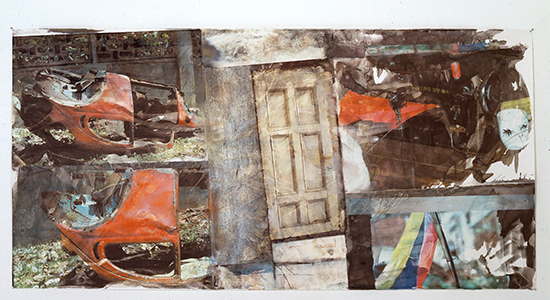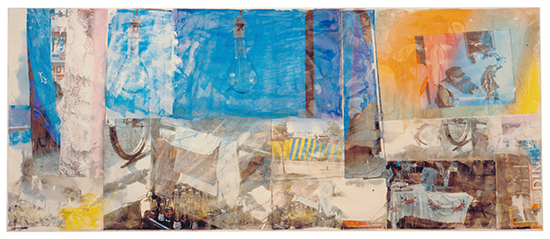William Blake divided the world according to the rubric of “the prolific and the devourer” without anticipating the possibility of the uncanny Robert Rauschenberg, an artist who could be both at the same time. The colossally thrilling exhibition of “Anagrams, Arcadian Retreats, Anagrams (A Pun)” at the cavernous Pace Gallery on West 25th Street, along with a focused exhibition of the Tracks series from 1976 (tire tracks impressed into clay) at Jim Kempner Fine Art on West 23rd, offer Chelsea gallery goers two opportunities to climb that peak of encyclopedic creativity one more time.
The “Anagrams” at Pace are large scale, linguistically playful paintings (including frescos) that Rauschenberg started making in the three-year runup to the vast Guggenheim retrospective in 1997 and continued making until 2002 (he died in 2008). He made these paintings by pushing the scale of the epic series of works on paper, Thirty-Four Drawings for Dante’s Inferno (1959-60), which still represents the Rosetta stone for the understanding of the artist’s iconography and technique.
.

"Red Risk (Anagram)" by Robert Rauschenberg, 1996. Inkjet dye transfer on paper, 60 1/4 x 119 3/8 inches. Photo by Kerry Ryan McFate / Pace Gallery ©Robert Rauschenberg Foundation/Licensed by VAGA, New York, NY.
.
Blowing up the transfer technique of that series (originally, soaking the magazine images in lighter fluid and rubbing them on paper with an empty ballpoint pen) to collect semi-transparent pictures, he then, with the bravura only he could muster (his friend and studio mate Jasper Johns was so much tighter) angled, swirled and layered them in symphonic pageants for which the term collage seems wholly inadequate even if it is technically right. The touch of the painter is in the sweeping gestures back and forth across the surface as he waved the squeegee with flourishes worthy of the Abstract Expressionists.
Rauschenberg by 1992 had devised with his team a way of replacing chemical inks with vegetable dyes soluble in water, yielding not just crisp imagery (when needed) but allowing the liquid color to pool and flow, stain and run to the edges as in a watercolor or the poured paintings of Morris Louis. The result, both chromatically and in the vertical ordering of the layered images, is an effect of simultaneity that lends the depth of a maelstrom.
The magisterial Fusion (Anagram) from 1996, on loan to Pace from the Whitney Museum, is the ideal introduction to the method. The painting’s icy blues, shifting like lace curtains across the light bulb and soda bottle pictures hovering beneath its limpid surface, are reminders of the artist’s “hoarfrost” (his term) effect in the Dante drawings.
.

"Fusion (Anagram)" by Robert Rauschenberg,1996. Inkjet dye transfer on paper, 60 1/2 x 144 3/4 inches. Photo by Kerry Ryan McFate / Pace Gallery ©Robert Rauschenberg Foundation/Licensed by VAGA, New York, NY.
.
Rauschenberg can certainly be a tease. The titles may be the point of entry, often pursuing color codes to the works, but I confess it had to be pointed out to me that the luscious vertical figure just off center in the piece, glowing with cardinal and magenta streaked with a highlight, was the pillowy, eponymous set of Lips (Anagram) proffered yet hidden in plain sight. Too much the intellectual, I was fixated on the blurred image of the Bronzino Allegory in the lower left corner, one of those welcome moments when Professor Rauschenberg teaches art history (Greek sculpture and the Sphinx have cameo roles in the show).
.

"Lips (Anagram)" by Robert Rauschenberg, 1997. Inkjet dye transfer on paper, 40 x 30 1/4 inches. Photo by Kerry Ryan McFate / Pace Gallery ©Robert Rauschenberg Foundation/Licensed by VAGA, New York, NY.
.
Rauschenberg decided that the Old Master Allegory needed to have all the dark drama of the original male faces scrubbed in a pale, stripped version of its squared figural geometry. He picks lilac as the tonic note in Lilac Role, surrounding a young woman in a t-shirt of that color with a zebra, an oxy-acetylene rig, and a neon sign flashing in the corner. Deciphering the encrypted anagrams and connecting the art history with the anthropological or even sociological implications of Rauschenberg’s vocabulary is half the fun of the show. “The world is my palette,” Rauschenberg boldly proclaimed. For once, this global boast is not bombast, since nothing that is human ever seems alien to him.
If his palette is all the world, then his tool kit included not just that oscillatory squeegee and the paint brush but a car tire, as the curator Robert Saltonstall Mattison reveals in a terrific show at Kempner. “Tracks” is devoted to the artist’s suite of clay, dirt and resin with fiberglass casts. Rauschenberg made these casts by rolling a tire over strips of clay set on plywood boards, generally late at night in the studio at Captiva Island, Florida and, one might imagine, after a beer or two.
Evoking a dance with a tire (I was reminded of the goat in the tire in Monogram, the masterpiece from 1955-59, the clay casts have some of the gestural appeal of a Franz Kline and the conceptual wit of the Automobile Tire Print experiment that Rauschenberg and John Cage performed. The experiment involved inking the rear tire of Cage’s Model A Ford and running it over 20 attached sheets of paper laid down on Fulton Street in front of the studio.
A touching apercu offered in the too-brief catalogue essay for the Pace show by Jonathan Fineberg redirects the viewer’s admiration for Rauschenberg the thinker from a voracious hunter-gatherer to a more tender, even passive recipient of the chaotic stimuli of his surroundings, none of which he seems to have missed or taken for granted. Fineberg, quoting Rauschenberg on his discomfort with the confessional egoism of the Abstract Expressionists, links this to his sense of “inferiority” (the artist’s dyslexia enters into this equation) in the face of a world he struggled to document.
I thought of John Keats, stunned by the epiphany of “negative capability” while writing a letter in 1817, describing the phenomenon as “when a man is capable of being in uncertainties, mysteries, doubts without any irritable reaching after fact and reason.” Rauschenberg said, “I grew up being reassured every day that I was inferior because of my dyslexia. I think my religious experience has built into my ethic an irreversible sense of inferiority … When I go to work I have to feel invisible to get away from the inferiority.”
The big-hearted Texan Rauschenberg was consumed by doubt, as was Cezanne. In the face of this insecurity, he insisted that the pictures he appropriated were “facts,” for instance. As a journalist, I attached myself to the painting titled Scoop, drilling deep into the array to find the News Building logo and wondering about the exact time and location of those umbrellas. A reporter navigates the freshness and truth lost to “news filters” as well as the inadequacies of the medium.
.
!["Scoop [Anagram (A Pun)]" by Robert Rauschenberg, 1998. "Scoop [Anagram (A Pun)]" by Robert Rauschenberg, 1998. Inkjet pigment transfer on polylaminate, 10' 3 3/4" x 15'. Photo by Kerry Ryan McFate / Pace Gallery ©Robert Rauschenberg Foundation/Licensed by VAGA, New York, NY.](https://hamptonsarthub.com/wp-content/uploads/2015/10/WEB_30472_RAUSCHENBERG.jpg)
"Scoop [Anagram (A Pun)]" by Robert Rauschenberg, 1998. Inkjet pigment transfer on polylaminate, 10' 3 3/4" x 15'. Photo by Kerry Ryan McFate / Pace Gallery ©Robert Rauschenberg Foundation/Licensed by VAGA, New York, NY.
.
Fineberg’s terrific point is that Rauschenberg, putting aside his own “will” or ego, was building our own heightened awareness of the unfiltered perceptions of our own present and bringing not just every available bit of information but all the technical tricks at his disposal (fresco, for example) to fuse shadow and substance. Epistemology and ethics meet in aesthetics, offering a truth in painting that remains all too rare in art history.
“I trust impulse, creative intuition and unmotivated spontaneity, but above all responsive action with as many filters that one can avoid,” Rauschenberg wrote in “About My Paintings,” a one-page text slowly and laboriously scrawled in block capitals that is used as the frontispiece to the catalogue. Then the rascal added his postscript: “Also—to arouse secrets or celebrate the unexplored truth or lies.”
.
!["False Witness [Anagram (A Pun)]" by Robert Rauschenberg, 1998. "False Witness [Anagram (A Pun)]" by Robert Rauschenberg, 1998. Inkjet pigment transfer on polylaminate, 96 x 59 1/2 inches. Photo by Kerry Ryan McFate / Pace Gallery ©Robert Rauschenberg Foundation/Licensed by VAGA, New York, NY.](https://hamptonsarthub.com/wp-content/uploads/2015/10/WEB_61069_RAUSCHENBERG.jpg)
"False Witness [Anagram (A Pun)]" by Robert Rauschenberg, 1998. Inkjet pigment transfer on polylaminate, 96 x 59 1/2 inches. Photo by Kerry Ryan McFate / Pace Gallery ©Robert Rauschenberg Foundation/Licensed by VAGA, New York, NY.
.
_________________________________
BASIC FACTS: "Robert Rauschenberg: Anagrams, Arcadian Retreats, Anagrams (A Pun)" remains on view through December 12, 2015. Pace Gallery is located at 534 West 25th Street, New York, NY 10001. www.pacegallery.com.
"Robert Rauschenberg: Making Tracks" remains on view through November 8, 2015. Jim Kempner Fine Art is located at 501 West 23rd St., New York, NY 10011. www.jimkempnerfineart.com.
__________________________________
Copyright 2015 Hamptons Art Hub LLC. All rights reserved.

Fondly recall the early 80s and openings we had (richard milazzo, colin de land, gretchen bender et al) in out-of-the-way spaces along ave a or ave c when Robert Rauschenberg would turn up to support and encourage the artists and writers. Magnanimous and generous when it meant so much to artists in an era different from our own (he’d have been in williamsburg today one supposes)